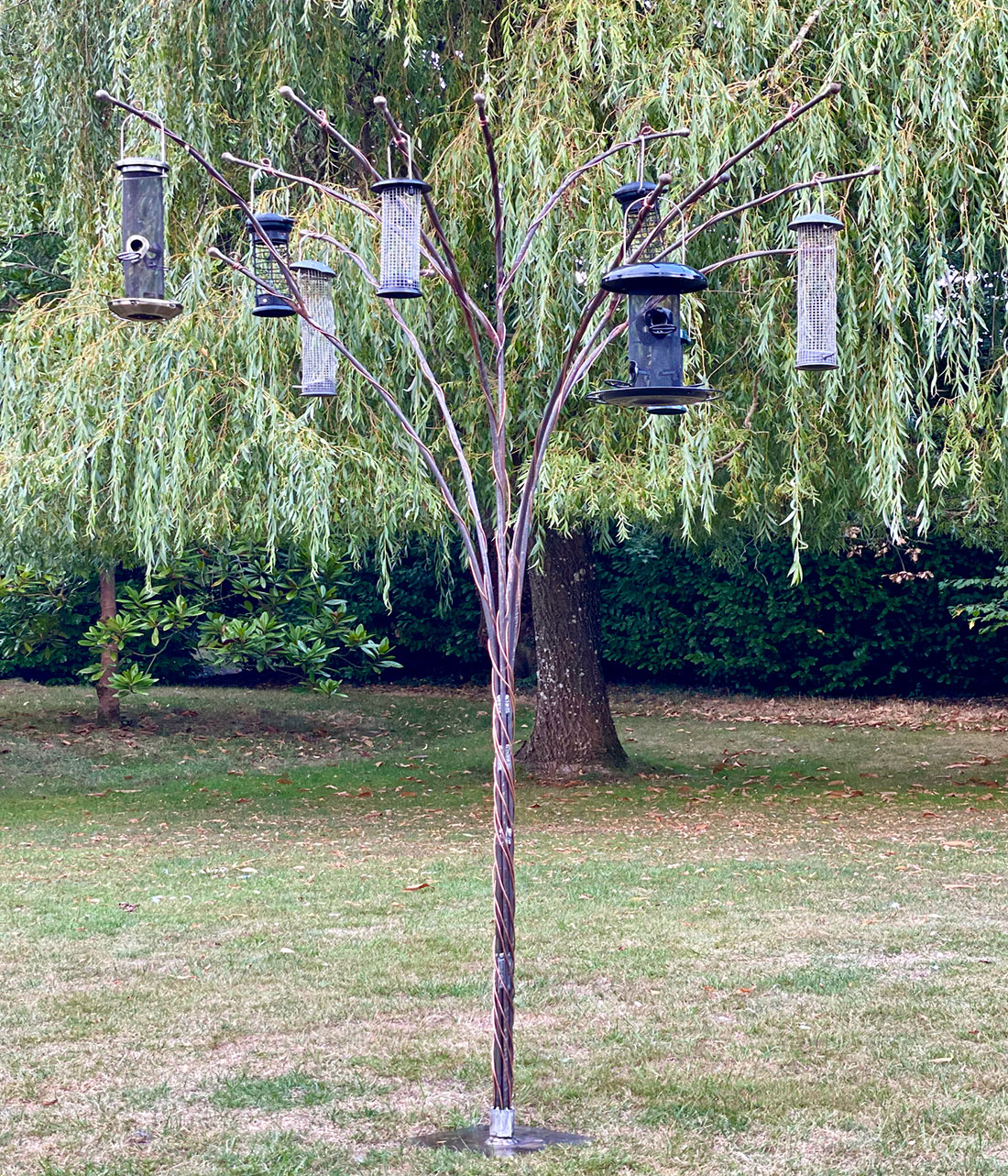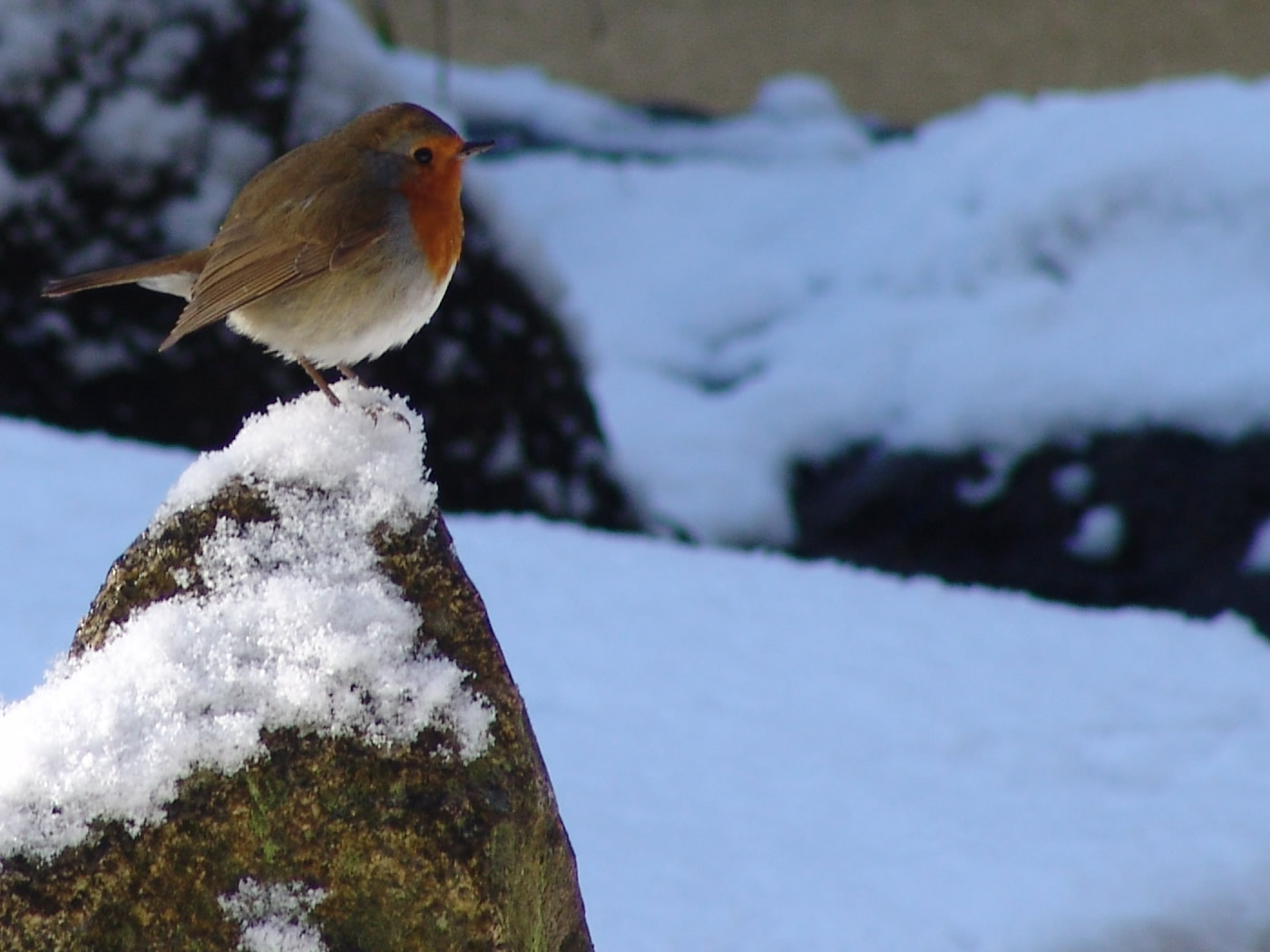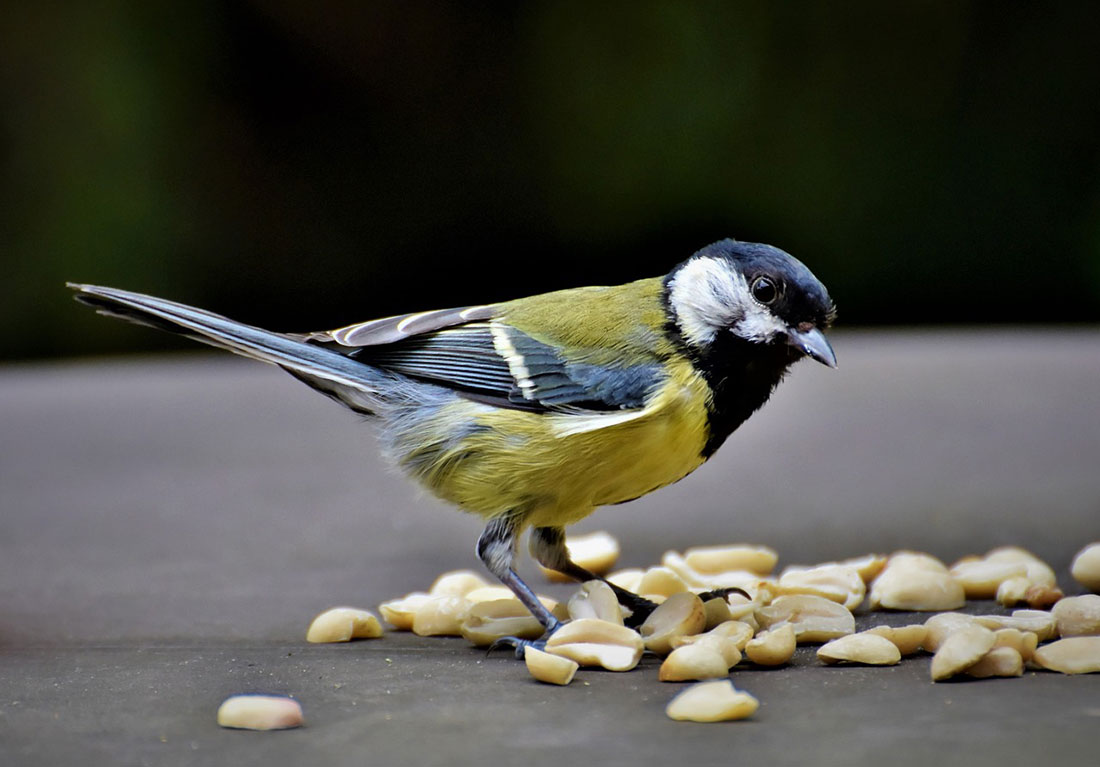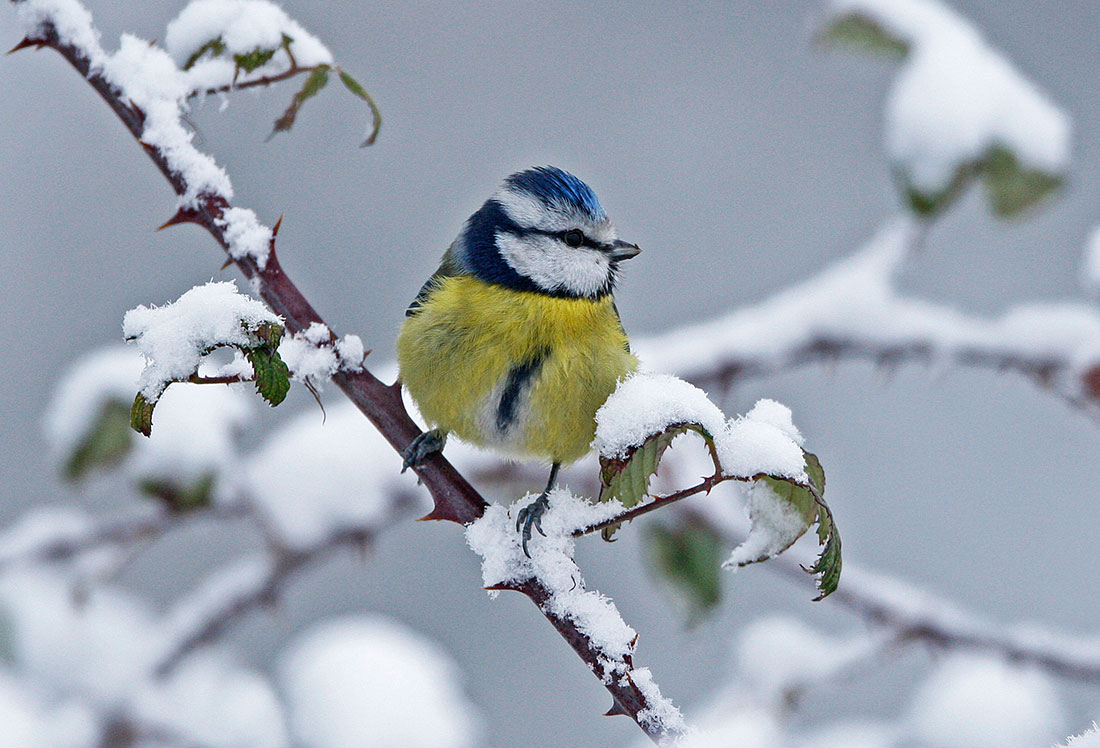
Different Types of Bird Feeders
One of my earliest memories of spending time with my Scottish granny was going out into her garden every morning, brushing away the snow when it fell, and scattering the ground with an incredible variety of food for her “birdies”! It was a ritual that I really looked forward to being part of and I adored sitting in the kitchen afterwards and watching the robins, nuthatches, siskins, tits, blackbirds, sparrows, dunnocks and many more wild birds feasting on their breakfast.
Weirdly though as a grown-up, I didn’t even consider feeding songbirds as part of my daily ritual until literally a few years ago. I must have been about 48 I think!!! I don’t know what changed, maybe I just thought they looked hungry! Or maybe I thought they felt left out? We have four sons who eat like an army and I was permanently creating food not only for them and our friends and family but also for, and with, my cookery school students! Even my husband wondered what I was doing and couldn’t believe I was spending money on feeding wild birds as well as our sons, dogs, chickens, friends and family. And I didn’t really have an answer, but I do wonder if perhaps it was the memory of happy times spent as a child. However, I was sent this quote and I lolled long and hard and offered it to him as an answer!
“As you age, it’s ridiculous how fast bird-watching creeps up on you. You spend your whole life being 100% indifferent to birds, and then one day you’re like, “damn is that a yellow-rumped warbler?”
But whilst he questioned my sanity he had no idea that the love was creeping up on him too! It wasn’t until he actually started calling them “my birds” and filling up the feeders before me that he realised he’d got the bird bug too!
It was this newfound interest and passion combined with the very sad demise of the tree near the house that we used to hang our feeders from that lead me to design ELIZABETH for him. She is a bird feeder tree and she was his birthday present. In August! See my post, Should You Feed Birds In Summer? for lots of chat on that topic!
What I then set about doing was finding the ultimate bird feeders to attract as wide a variety of songbirds as possible.
There are LOTS of different types of bird feeders available on the market made by LOTS of different brands. The bird feeder types we have are long-lasting and strong and they are also the best type of bird feeder for cleaning.
Being able to clean your feeder is crucial because birds are susceptible to illness and disease. Illness can be caused by feeding birds the wrong food and from mould, fungus and bacterial growth which can be found in old (and often wet) food. It is really important to keep an eye on the feeders at all times of the year. Nuts and seeds can get very wet and grow mould at an alarming rate in the UK. This mouldy food needs to be discarded and then the feeders need to be cleaned using hot soapy water and then they need to be dried thoroughly. At this point they can be refilled with fresh food and rehung in the garden. Don’t be put off by this – it is really easy to manage and as you enjoy watching the birds feed in front of you their preferences will become obvious and you will be able to work out how much to offer at a time and therefore prevent mould building up.
Birds eat much more when it is really really cold and not so much when it’s raining – to be honest I think they prefer to take shelter rather than getting soaked! They eat more peanuts in the winter than they do in the summer and I don’t offer suet when it gets warmer. Sunflower hearts are devoured all year round! Seeds are enjoyed in the winter and in the summer and by parents of young families.
In the summer months the warm weather can also promote disease. Viruses live longer in warmer weather and can be transferred from bird to feeder and from feeder to bird so again it is good to buy feeders that can be cleaned easily. I often use a 10% bleach solution or a spray such as the ARK-KLENS Disinfectant Spray. Just spray it on and wipe or rinse off every few fillings. It’s also a good idea to sweep up or mow up any husks or dropped seeds.
As you can imagine there are different types of bird feeders for different birds because different birds like to eat different foods and so to answer the question “what type of feeder should I use?” it helps to think about what birds you are hoping to draw to your garden.
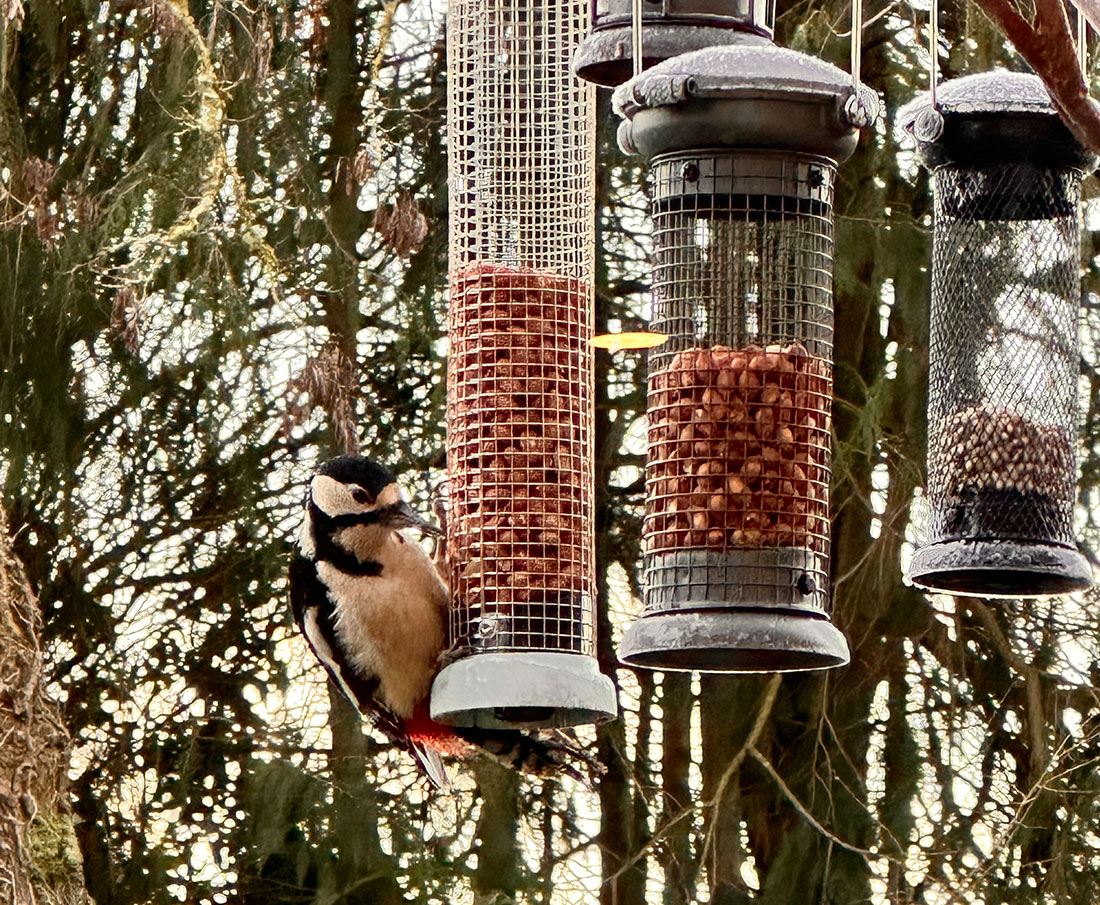
Woodpeckers, nuthatches and all varieties of tits including those amazing long tailed tits LOVE a peanut! Make sure you use a feeder with holes that aren’t so small that the songbirds get their beaks stuck but aren’t too big so as to be able to remove the whole nut at once.
Finches, tits, and sparrows LOVE sunflower hearts. I use a tubular mesh feeder which has been specially designed to house them so the mesh is the perfect size.
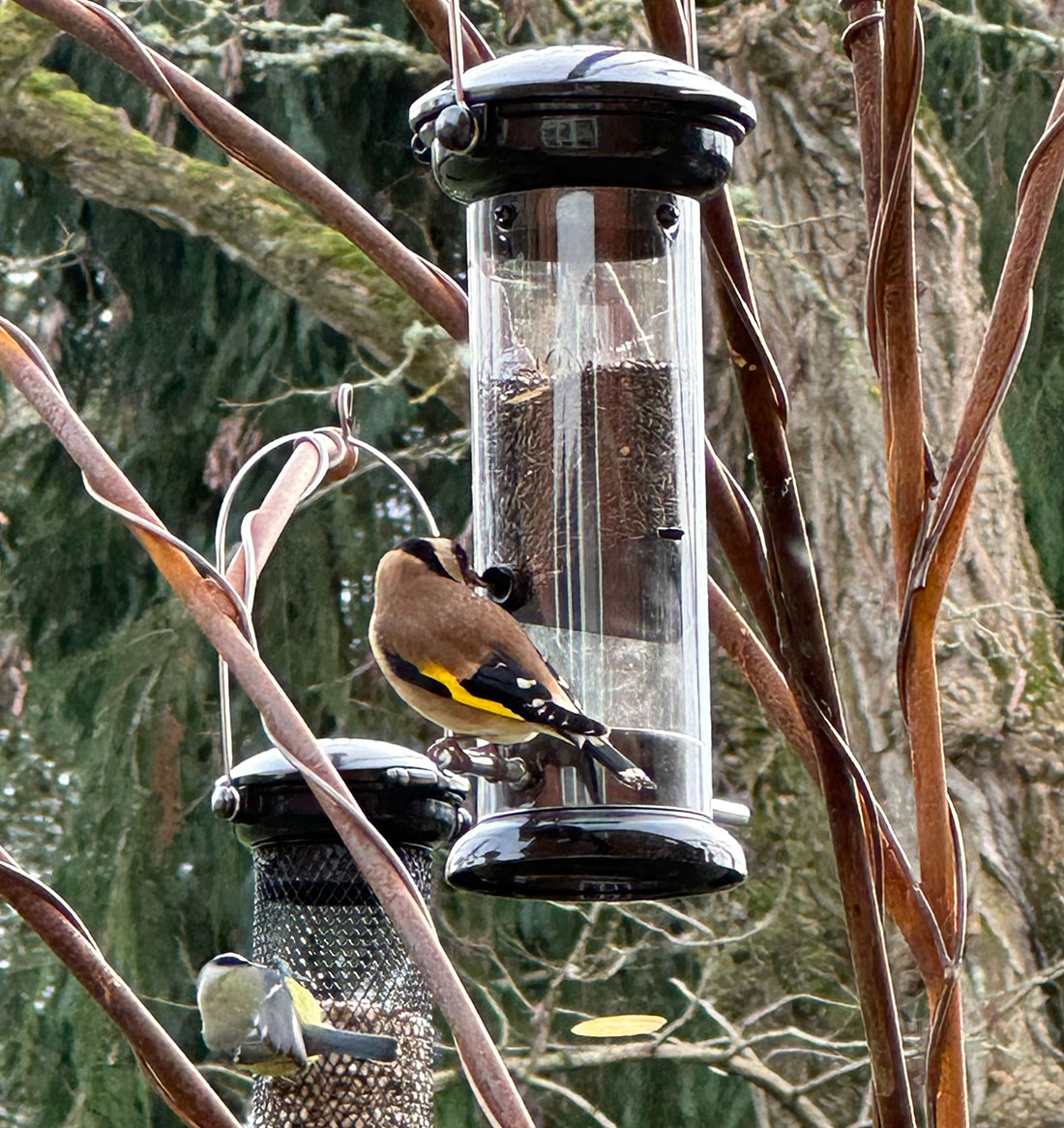
Finches (gold, green, bull) also ADORE nyjer seed. How we discovered that British songbirds would like this native seed of Nigeria I don’t know (probably something to do with migration and I am researching this) but love it they do. To offer this food you need a specific plastic tubular feeder with a tiny hole for access.
Blackbirds, chaffinches, robins, wrens and sparrows like to feed from the ground – seeds and mealworms being favourites. They will also feed from trays so I tend to attach a tray beneath my mixed seed feeders.
Tits, robins, blackbirds, dunnocks, nuthatches, wrens and starlings flock to feeders offering mealworms or any type of worm!
Doves, pigeons and pheasants will eat barley and wheat and other seeds and grains from the ground or large enough trays.
The Main Types of Feeders in the UK
Tray or Platform Feeders:
A tray or platform bird feeder is the simplest and most versatile of all bird feeders. It consists of a square or rectangular platform (base) with side pieces to prevent the birdseed from spilling over. A tray feeder is what I call a bird table.
Hopper or House Feeders:
Hopper bird feeders look similar to bird tables but are built like a house, a lantern or a gazebo and are typically constructed with multiple sides and a roof.
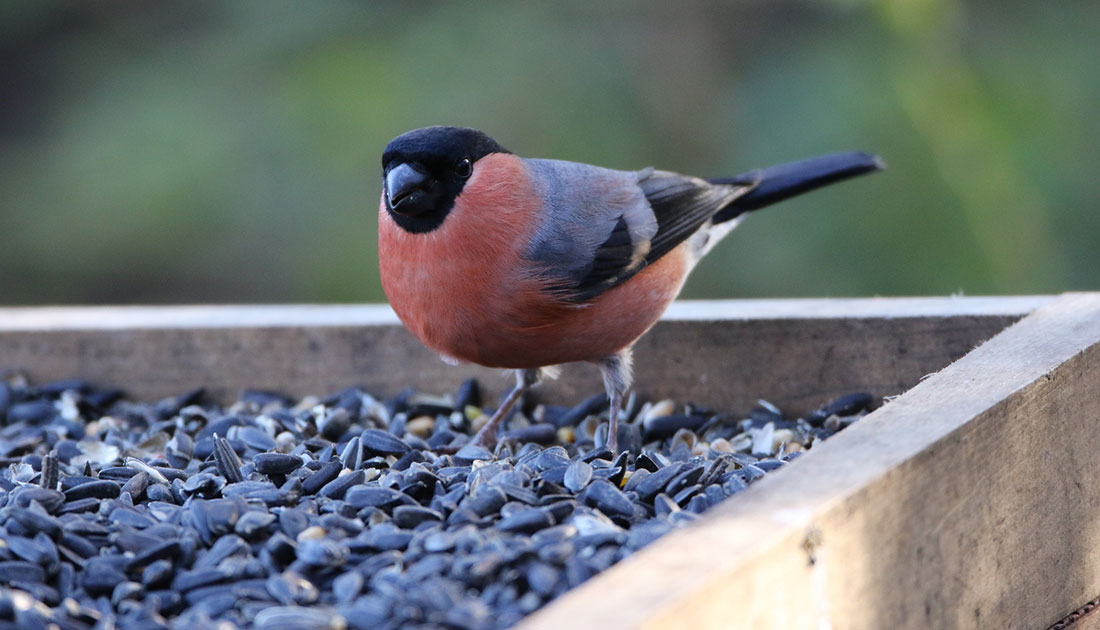
Window Feeders:
As the name suggests, window feeders mount directly to the windows of your house and allow for a more intimate bird-watching experience since you are able to view birds from the other side of a window.
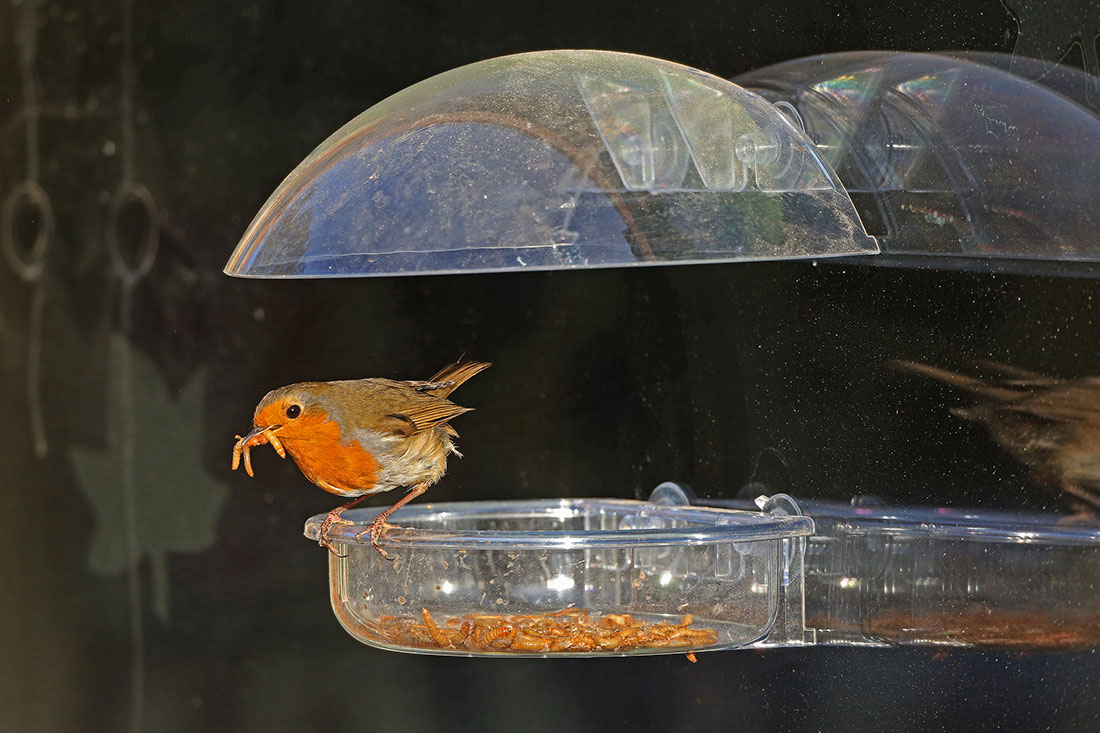
Tube Feeders:
A solid tube with perches and seed openings around the bottom and ports up the sides possibly a tray at the base. A tube made from wire mesh or clear plastic with solid wood or metal top and bottom. Tubes can be designed to hang from trees or lines and some tube bird feeders are not a round tube shape but a square shape.
There are different types of tube feeders for different foods and it is important to choose the bird feeder types best for the food you would like to offer:
Peanut Feeder – Surrounded by mesh that is the perfect size to allow for beaks to peck the nuts whilst not allowing them to come out whole.
Mixed Seed Feeder – made from clear plastic with perches and ports to allow the birds to grab the seeds they like.
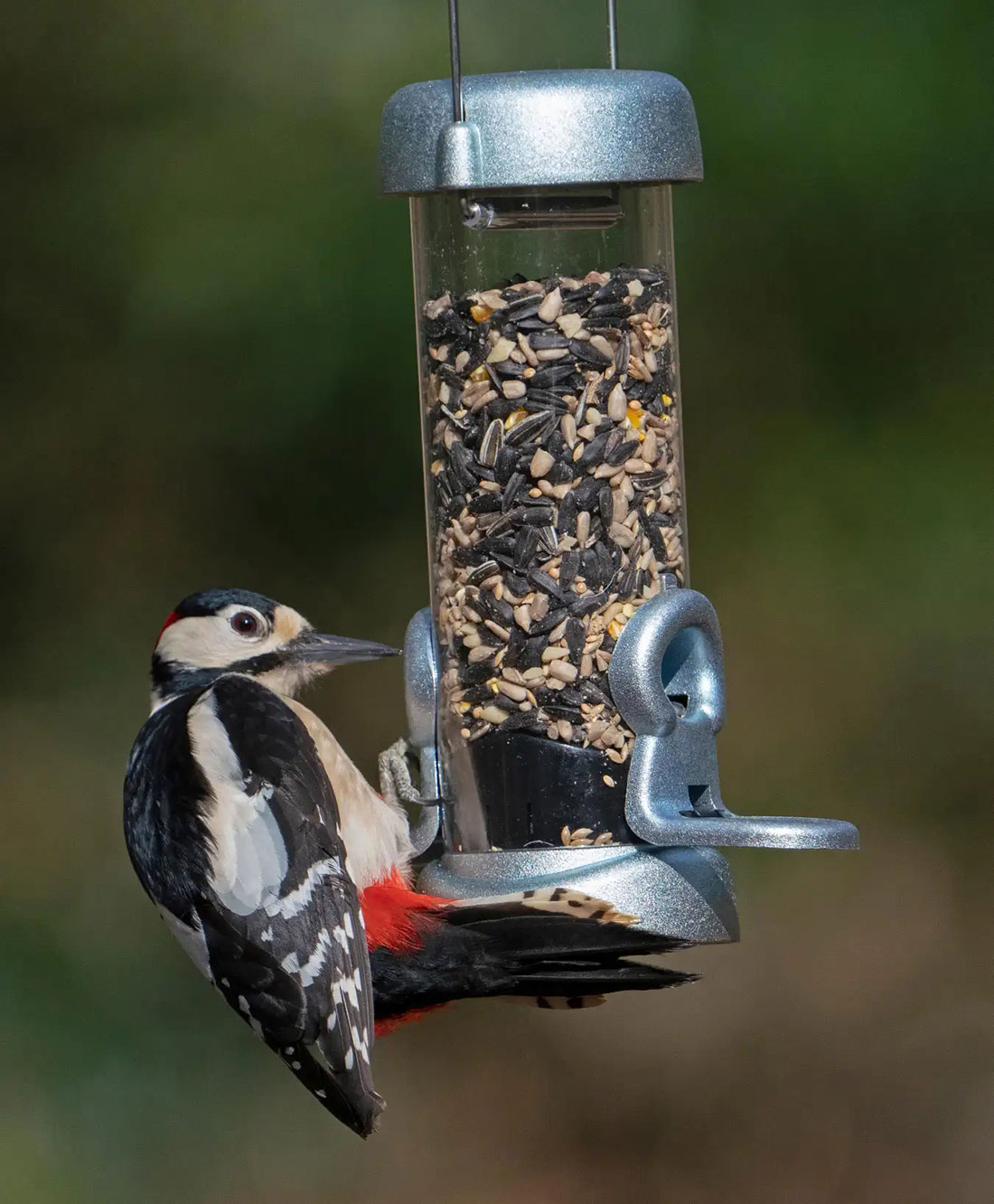
Fat Ball Feeder – a metal cage structure which allows the birds to pick at the fat balls without them falling out.
Suet Pellet Feeder – a smaller cage structure than the fat ball feeder designed to hold suet pellets.
Sunflower Heart Feeder – surrounded by mesh smaller than the peanut feeders which also allows small birds to peck at the seeds whilst holding them in place.
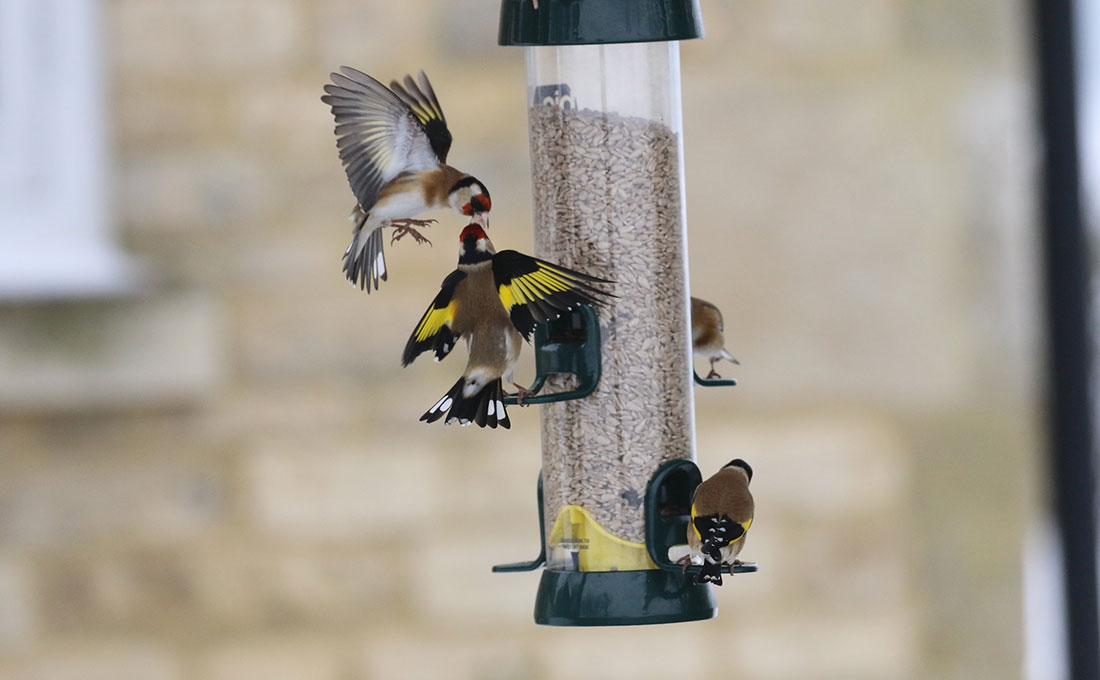
Nyjer Seed Feeder – made from clear plastic tubes like the mixed seed feeders but with tiny holes above perches from which songbirds can pick out these tiny seeds.
Mealworm Feeder – also made from clear plastic tubes with large holes just above the base tray. The tray catches the free-flowing food.
Squirrel Proof Feeders
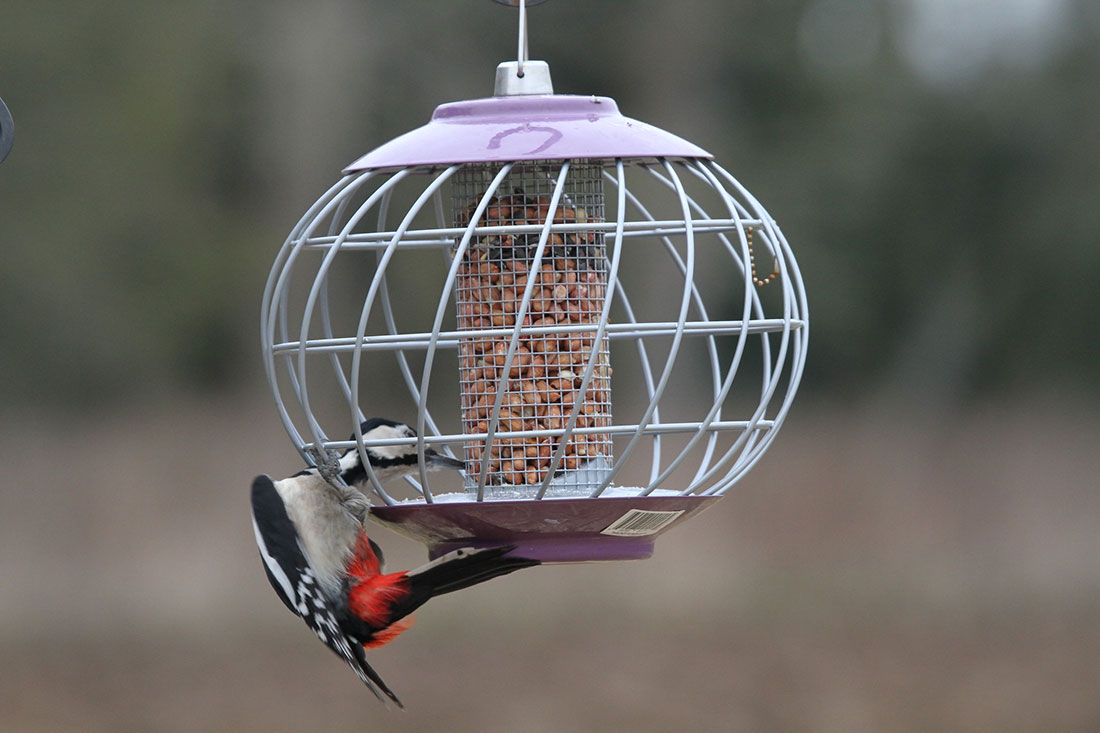
I can’t write about feeders without discussing that most types of bird feeder come with a squirrel deterrent option! I have not yet seen a squirrel eating from the feeders hung on our feeder tree ELIZABETH, but I know they are out there! And it is wonderful that it is possible to feed birds without feeding the squirrels.
Gardeners’ World has written a great blog on the best bird feeders so have a read. Or get in touch if you have any questions.
Photos sourced from the Vine House Farm collection.

